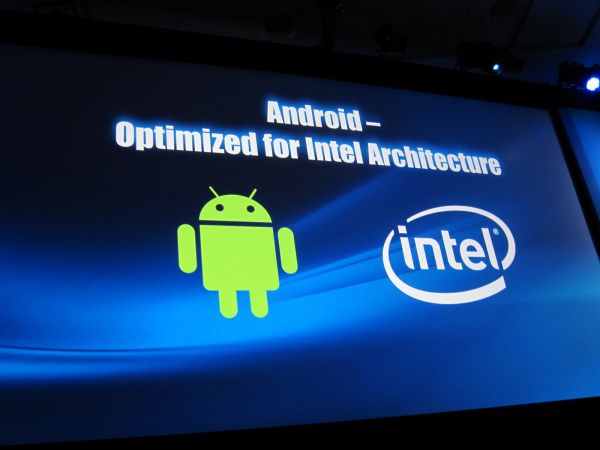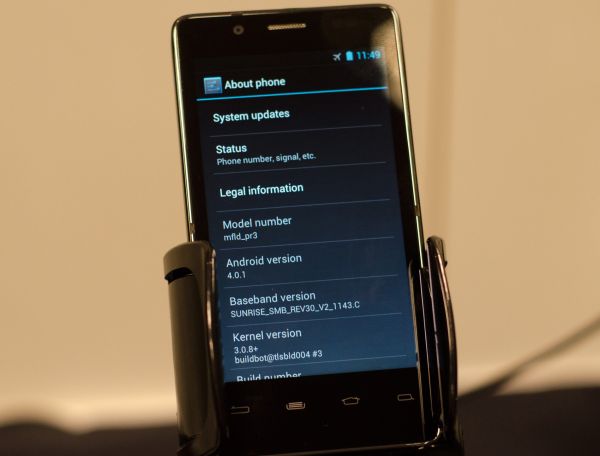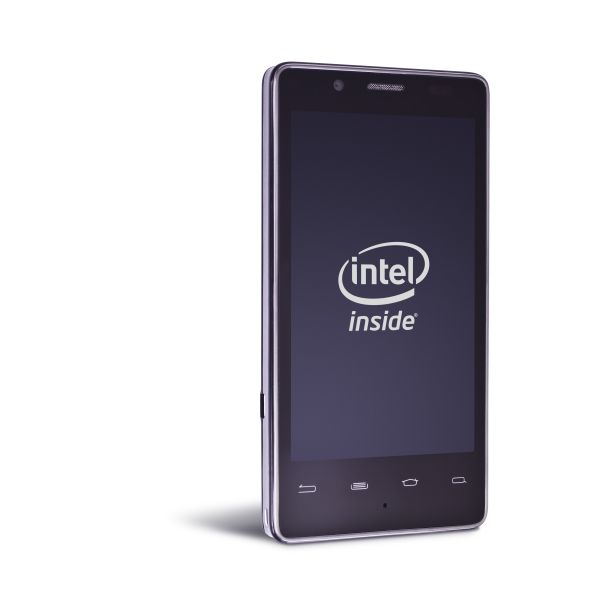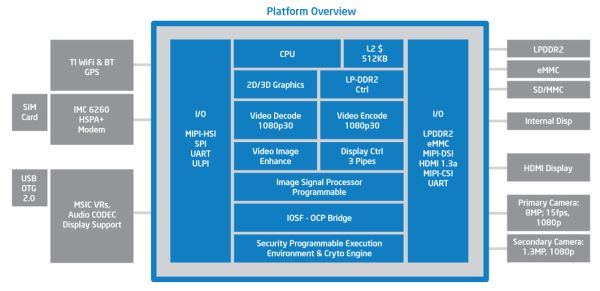Intel's Medfield & Atom Z2460 Arrive for Smartphones: It's Finally Here
by Anand Lal Shimpi on January 10, 2012 8:00 PM ESTWhat's Different This Time Around: Google & A Sweet Reference Platform
Intel has been talking about getting into smartphones for a couple of years now, but thus far it hasn't been able to secure a single design or partnership that that resulted in a product actually coming to market. This time around, things are different. The major change? Focus, and Google.
Intel originally had ambitions of enabling its own mobile OS with the help of Nokia (Moblin/MeeGo). Intel also wanted to support Android as well, however its attention was clearly more focused on the Moblin/MeeGo effort. Similar to the wake up call that pushed NVIDIA to focus exclusively on Android, Intel has now done the same.
At IDF last year Intel and Google announced a partnership and the intention to bring all future versions of Android, starting with Gingerbread, to x86. Since then Intel has ramped up the software engineering engine, going into the Android source code (Gingerbread, Honeycomb and now ICS) and fixing bugs. Intel's goal is to deliver the most stable version of Android as a result of its efforts. Intel is also submitting its changes upstream to the AOSP, which should help improve the Android experience even on ARM platforms.
Under the leadership of Mike Bell (formerly of Apple and Palm), Intel has also created an extremely polished Medfield reference design. This is the same design shown off at IDF last year (apparently there's an even thinner one floating around somewhere), but what separates it from other reference designs we've seen from SoC vendors is that the Medfield reference platform was designed to be a polished phone that could theoretically be rebranded and resold.
Intel knew the onus was on itself to prove that Medfield, Atom and even just x86 was power efficient enough to be delivered in a compelling form factor with competitive battery life. Paul Otellini gave Mike carte blanche access to any of Intel's resources. Instead of having to work with existing Intel groups, Mike was allowed to assemble his dream team of engineers. The team Mike built is what he felt he needed to not only bring Medfield to market, but also to build the a first class Atom based smartphone.
The result is this:
Internally it features Intel's own XMM 6260 HSPA+ modem. Intel claims LTE is on the way although there's no ETA on that.
WiFi in the reference design is provided by TI's 1283 controller. Intel's wireless team does not have a a WiFi solution that's low power enough to work in a smartphone, although after the recent restructuring the team has now been tasked with building an ultra low power solution that can.
The display is a somewhat unusual 1024 x 600 panel, with support for 1080p30 (and 1080i60) output via HDMI. The SoC specs are identical to what I've already discussed: 1.6GHz max CPU clock and a 400MHz GPU clock.
The reference platform is not only smartphone sized, but Intel has built its own qualification labs that mirror those of the carriers to ensure quality and convince its customers of the platform's legitimacy. In essence, Intel has built its own miniature smartphone design and test center.
The Medfield reference platform is available for use by any of Intel's customers, and indeed that's what's already happening. Lenovo's K800 is based on a modified version of Intel's reference platform, and I wouldn't be surprised if more aren't on the way.
All of this sounds a lot like Intel's efforts in the motherboard space over a decade ago where it started providing motherboard manufacturers with reference designs that they could modify if they desired. The effort helped significantly reduce time to market and allowed the motherboard makers to focus more on specializing on what they were good at.
The Medfield reference platform is designed to do the very same for smartphones. Intel wants to provide its partners with a well designed, stable smartphone platform. If they choose to use it, they can shave off a significant amount of development time and spend more of their time on software or simply bring a good reference phone to market in a quick fashion. I'm not entirely sure I've seen many players in the Android space that are actually all that great at software development, but Intel believes anything that shortens time to market will be appreciated.
I asked Intel if it has any plans to offer the reference platform unlocked, direct to customers. Unfortunately the answer at this point is still no. I suspect that Intel is more interested in building its customer base rather than circumventing it.
















164 Comments
View All Comments
hechacker1 - Tuesday, January 10, 2012 - link
What's impressive to me is the fact that you have an Atom, which powers generations of netbooks, running as a SoC using only milliwatts of power most of the time.I'd love to see a tablet/netbook version with a huge battery that could run for the better part of a day.
It would even do really well as a media server/HTPC if only it had I/O bandwidth for hard disks and HDMI outputs with surround sound.
aNYthing24 - Tuesday, January 10, 2012 - link
Not really all that impressed. By the time it's out, you'll start seeing phones ARM Cortex-A15 based SoCs which are about 40-50% faster than Cortex-A9 based SoCs.MonkeyPaw - Tuesday, January 10, 2012 - link
Yeah, I'm still on the naysayer's side, too. The SOC market isn't as slow to develop as x86. We've seen rapid improvements over the course of the last 4 years. Where the next generation of x86 may get you 15% more performance (if you can even utilize it all), SOC's are gaining in relative leaps and bounds, and the improved performance is quite noticeable. I went from an iPhone3G to an iPhone4, and every aspect of performance was clearly better. Everything loads faster, you can "multitask" and take better pictures and HD video, and the battery life is still better. That was in 3 years time. 3 years from now looks to be just as positive. That means Intel has the tougher road. It took them 5 long years to get Atom DOWN to sub 1W TDP and into a phone, while ARM SOCs have always been working inside this power design.That said, I sure as heck hope this doesn't fowl up Android Market any further. I've said it before, App compatibility is already not a given due to OS version fragmentation. Adding x86 will just require more effort on the developer's part, which might doom Intel's early chances anyway.
Rest assured, Intel will dump billions into this and not go away. They can't afford to miss out on this market. I wonder when AMD will figure that one out...
yvizel - Wednesday, January 11, 2012 - link
Clearly shows how little do you know... WOW.Griswold - Thursday, January 12, 2012 - link
He may know little, whereas you know NOTHING.Back under your rock, peanut.
stadisticado - Wednesday, January 11, 2012 - link
I gotta say...I really disagree with your assessment. ARM SOCs have indeed improved a lot over the past few gens. However, that is largely due to moving to new nodes, going from single to double to quad core uarch and finally in moving up the ladder on ARM architectures. Now, Intel is jumping in here, let's assess along these vectors:I don't think anyone is arguing Intel has process leadership, perhaps not in SOC, but at least their 32nm node is competing directly with TSMC 28nm.
As for the core wars, I predict Intel goes the route they go in laptops: dual core with HT is the right balance of perf/power for most applications. That said, I guarantee we see quad cores with HT for tablets in 2013 on 22nm.
The uarch question is yet to be answered. Ultimately we'll have to see how A15 stacks up against this single core Saltwell and the dual core that's coming in the Clovertrail platform.
name99 - Wednesday, January 11, 2012 - link
What Intel naysayers (at least the ones that aren't twelve years old) say is that x86 complexity puts SEVERE constraints on how fast Intel can spin these chips around. It took something like 7 years for Nehalem to move from initial design to fully validated and ready to ship.Now, in the "traditional" x86 space, this has not been that much of a problem for Intel for a while because they run so much design in parallel, so that each team has its new CPU ready each year. Even so it does occasionally cause problems when Intel misjudges where things will be in the future and misses a feature for a few years. The most obvious example of this was x86-64, but we saw it again regarding moving the memory controller on-die, and regarding how powerful users expect on-chip GPUs to be.
So, when it comes to Atom:
(a) do they have multiple design teams in place, so that we can now expect a steady rate of serious improvement every year. Or is this the fruit of their one major design team, and we can expect it to stand still, apart from minor tweaks, for the next three years or so?
(b) are they willing to modify the SOC as requested by different vendors, to improve power or reduce size? What if I want a custom flash controller on the SOC or a better than average camera processor? Maybe this doesn't matter --- but maybe it does. I think honestly none of us know. What we DO know is that the phone market is different from the old-school PC market. Unlike old school PCs, size (fewer parts) and power (better integrated parts) matter a huge amount, which gives an advantage to CPU vendors who are willing to tailor their SOCs to include anything extra the manufacturer wants, while tossing anything they don't want.
Finally: "ARM SOCs have indeed improved a lot over the past few gens. However, that is largely due to moving to new nodes, going from single to double to quad core uarch and finally in moving up the ladder on ARM architectures. Now, Intel is jumping in here, let's assess along these vectors:"
This process (for ARM) has not stopped. ARM-64 is a COMPLETELY new architecture, optimized for power and performance based on everything ARM has learned over the past few years, and tossing various components of the architecture that no longer make sense. ARM-64 devices plan (as far as I know) to be compatible, during the brief period that is necessary, to have a separate ARM-32 core on die to handle ARM-32 binaries --- no crippling of either the ARM-64 architecture or the core design in order to allow 32-bit binaries to still work with it.
The point is that ARM is both improving their underlying architecture aggressively, AND that they are doing everything they can to ensure that they can remain nimble and easily able to spin out new cores with new ideas as the market evolves. Compare with Intel and their 7 year design cycles...
stadisticado - Wednesday, January 11, 2012 - link
On the 7 year design cycle: How long ago did ARM Holdings start RnD on A15? Whats the cycle time for that product to go from scratch to inside a product? That 7 year cycle you're quoting is literally from the first time the name showed up in a design document to ship, which I don't feel is a good comparative metric, especially for SoCs which share multiple common blocks across gens.Does Intel have more design teams on Atom? No idea - but looking at the roadmap they have Atom on they basically have to. One team is not capable of spinning Medfield and pushing the 22nm Atom out the door next year and then 14nm the year after.
Basically you're stipulating that ARM is inherently faster than Intel in this space. Its yet to be demonstrated but I'm stipulating that is going to turn out to be a bad assumption.
PubFiction - Thursday, January 12, 2012 - link
Intel did not have a good dedication to atom but they are now getting there. So ARM obviously had the advantage before. Intel considered Atom second rate stuff to put on old nodes.Also while the design of a full desktop CPU is long from start to finish I do not think it has anything to do with x86. It is more about just competing at the highest end. Itanium was no walk in the park. And so far no other architecture has beat x86. At the very least it still takes anyone else a long time to design chips.
The reason ARM moves faster is their chips are so much more simple. And atom is moving in that direction.
Intel is a scary competitor for anyone in any processor space. Once they dedicate to something it will get competitive. Does not mean they will win, but if these chips have this performance and actually do ship this year it they may not beat A15 but they will be good enough to stick in phones. And that is the start intel needs.
zeo - Saturday, January 14, 2012 - link
Yes, Intel had the ATOM on a slow 5 year product cycle but now they are switching it to a 2 year cycle for similar rate of advancement as Intel's higher end chip offerings.The 22nm Silvermont update coming out in 2013 will be when the switch is official and we can start expecting the usual year by year tic toc of advancement.
For example, Silvermont is more than just another die shrink but also the first major architectural change for the ATOM. Like Out Of Order Processing, as well as adding new technology like Intel's Tri-Gate Transistors.
Intel ATOMs also will be supporting a range of 1 to 8 cores. The 8 core version presently being focused for the server market, but it's likely Intel will leverage multiple cores for most of their intended product lines.
Cedar Trail is for example dual core for both the high end and low end chip versions.
While the Clover Trail and Medfield shows Intel is making progress of SoC and improving power efficiency to be at least good enough to start competing in the mobile market.
Though we still have to see if Intel can be price competitive and Intel will likely need to offer even better performance than ARM can offer with their next gen offerings to start to really expand into the mobile market. So Intel has a lot riding on coming through in 2013.